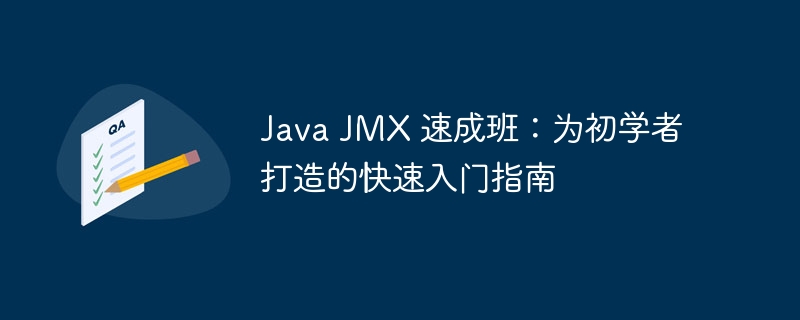Home >Java >javaTutorial >Java JMX Crash Course: A quick start guide for beginners
Java JMX Crash Course: A quick start guide for beginners
- 王林forward
- 2024-02-21 08:09:07495browse

Java JMX Crash Course creates a quick start guide for beginners to help readers quickly master the core concepts and application skills of Java JMX technology. This article starts with basic concepts and gradually guides readers to understand the working principles, common application scenarios and practical skills of Java JMX, aiming to enable readers to quickly get started and apply it in actual projects. No need for tedious nonsense, go straight to the topic and take you into the wonderful world of Java JMX!
Java Management Extensions (JMX) is a set of Java api and tools used to monitor and manage Java applications and resources. This guide will provide beginners with a quick introduction to JMX, covering basic concepts, steps, and sample code.
JMX IntroductionJMX allows applications and components (called managed beans or MBeans) to expose their state and behavior information so that they can be monitored and managed remotely by external tools or clients. MBeans provide an interface to the manageable aspects of an application, such as properties, operations, and notifications.
Install JMXJMX is shipped with Java
jdk. You need to make sure you have the JDK installed and the JMX API added to your project.
Steps to get started1. Create MBean interface
Create an MBean interface that defines MBean properties, operations, and notifications.
public interface MyMBean {
String getName();
void setName(String name);
}
2. Implement the MBean classImplement the MBean interface and provide the implementation of its properties, operations and notifications.
public class MyMBeanImpl implements MyMBean {
private String name;
@Override
public String getName() {
return name;
}
@Override
public void setName(String name) {
this.name = name;
}
}
3. Register MBeanUse MBeanServer to register MBeans in JMX.
MBeanServer mbs = MBeanServerFactory.createMBeanServer();
mbs.reGISterMBean(new MyMBeanImpl(), new ObjectName("my.domain:type=MyMBean"));
4. Access MBeanUse tools such as JConsole or write a program to connect to the MBeanServer and access the MBean's properties and operations.
MBeanServerConnection connection = MBeanServerInvocationHandler.newProxyInstance(
MBeanServerFactory.findMBeanServer(),
new ObjectName("my.domain:type=MyMBean"),
MBeanServerConnection.class,
false);
String name = (String) connection.getAttribute("my.domain:type=MyMBean", "Name");
Sample codeThe following is a complete JMX entry sample code:
public class JMXExample {
public static void main(String[] args) throws Exception {
// 创建 MBean 接口和实现
MBeanServer mbs = MBeanServerFactory.createMBeanServer();
MyMBean mbean = new MyMBeanImpl();
// 注册 MBean
mbs.registerMBean(mbean, new ObjectName("my.domain:type=MyMBean"));
// 访问 MBean
MBeanServerConnection connection = MBeanServerInvocationHandler.newProxyInstance(
MBeanServerFactory.findMBeanServer(),
new ObjectName("my.domain:type=MyMBean"),
MBeanServerConnection.class,
false);
String name = (String) connection.getAttribute("my.domain:type=MyMBean", "Name");
// 设置属性和调用操作
connection.setAttribute("my.domain:type=MyMBean", new Attribute("Name", "New Name"));
connection.invoke("my.domain:type=MyMBean", "printName", new Object[] {}, new String[] {});
}
}
in conclusionThis article provides a quick start guide to JMX, covering basic concepts, getting started steps, and sample code. By using JMX, you can effectively monitor and manage Java applications, thereby increasing application reliability and availability.
The above is the detailed content of Java JMX Crash Course: A quick start guide for beginners. For more information, please follow other related articles on the PHP Chinese website!

